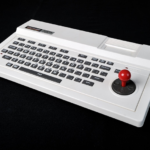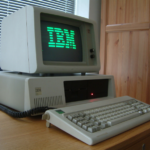Welcome to the Year of Sierra.
Hi. I’m Lostwolfe.
And I have something of a problem.
I love adventure games. More specifically, I love the very old school adventure games made by Lucasarts and Sierra On-Line. The trouble with Lucasarts is that there aren’t very many games that are adventures that I can talk about in a year. Oh. There’s probably a way I could do that, but it would mean stretching twelve titles [or so] across the whole year with some kind of filler for the other weeks where I need to write something. And while I think I could make a case for writing about the movies Lucasarts made, too, I’m not sure I have the stomach for talking about the Star Wars Holiday Special.
So. That leaves us with quantity and Sierra made a TON of games in the late eighties and early nineties.
Let’s get to that, then.
First, I think it makes a little bit of sense to talk about my history with Sierra On-Line.
And to talk about that, we need to talk a little about the summer of 1986.
At the time, I had a buddy who lived eight hours away by car. And religiously, every summer, I’d drive down there and we’d have a grand old time just hanging out. At first, this meant playing Atari games and coin-op games at his house, because one of his father’s friends [I think I’m getting this story straight] owned an arcade and he’d just loan them cabinets every now and then.
![This screenshot of Car Action [Bump 'n Jump/Burnin' Rubber] shows your car from above as it jumps over a huge lake while other cars try to impede your progress.](http://twinstiq.com/wp-content/uploads/2020/01/01_yos_car_action-150x150.png)
This was how I learned that – in Car Action [Sometimes called Burnin’ Rubber, dependent on where you are] – if you didn’t bump and kill any of the cars on the road as you were driving, you’d automatically get 50,000 points for clearing the stage.
When I went home and took this knowledge to my local arcade, a small handful of people were blown away. [In fact, the first time I was playing it and a guy was hanging out and watching me, he was VERY perplexed and was trying to nudge me into blowing up all the cars. I told him to be patient and then broke his score in half and, well, he was amazed and surprised.]
So, we played a lot of the old Star Wars cartridges and a lot of Car Action and a ton of Ladybug. [Ladybug’s a MUCH better Pac-Man. Fight me ;)]
It’s safe to say that I had the bug for video games.
But the computer market hadn’t settled down yet, and I was absolutely not sold on the home console market. So...I compromised. I bought a Spectravideo machine.
For those who don’t know, the Spectravideo was a doomed computer that SpectraVision farted out in the mid-eighties. They made a couple of machines that were also side-along compatible with the MSX [a much better supported machine] and also SOMETIMES the PC.
The MSX had no adventure games.
Everything was either based on waves or high scores. So it was just another in a long line of machines that were trying to cash in on the coin-op wave.
But the thing is: the Spectravideo left me with an appreciation for computers and computing. It came with it’s own BASIC and there were a couple of listings for games that you could type in and try.
And while I never did that, I did realize – right there and then – that computers were going to be a pretty big deal.
Fast forward to 1986.
It’s a balmy day.

My buddy’s Dad had an office that looked out onto his driveway, and through the window, we could see trees swaying in the background. Everything past the window was green and placid. Since he lived in a cul-de-sac, there was very little traffic.
The new thing in the office was an enormous PC. It covered everything.
At the time the XT’s of the day were behemoths. They were all solid black and beige constructions that had very little room for colour in their design. The only little splash of red was on the reset button and SOMETIMES, you’d get a tasteful IBM logo in blue somewhere on the chassis.
It had a tiny hard drive, no sound chip and it couldn’t display colour at all. Everything was in shades of black and white. Or, in this case, shades of black and green, because his Dad had opted for a monitor like that. You COULD get amber versions of the same thing and actual white variations, too, but green was – as far as science went – the best on your eyes, so most people had those.
Plus, in a very cyberpunk way, I guess, the green just “felt” right. It FELT like the colour a computer interface should be when what you were doing was typing commands in and getting responses out like “Abort, Retry, Ignore, Fail?”
It also had no mouse. So, really, you were forced to type in commands or bust. [Though, at the time, Windows 1 was a year away and the whole idea of a GUI was – for most PC users – a bit of a pipe dream.]
This lead to a type of user that liked to solve puzzles. Which, in turn, gave rise to a type of game that was all about puzzle solving: the adventure game.
There were LOTS of adventure games before Sierra showed up – Infocom was making a name for itself by producing sometimes silly and irreverent games alongside deep and interesting tales that you could sink your teeth into.
But Sierra was...to quote a song lyric from the time – "a kind of magic."
And I was about to get my very first taste of this particular brand of magic.
On that balmy day, my friend also pulled out a bunch of disks.
He had friends and those friends had connections, so he had a pretty wide variety of games at hand. None of these were legal copies, because in that day and age, copying was just how you got games. The stores certainly didn’t sell them, and when they did, their selection was so anaemic as to be prohibitive.
As a terrible example, the first PC game I ever bought with my own money was Mindfighter, because that’s about all they had at the store I went to.
Let that sink in for a minute. There were very few computer stores. Let alone computer game stores. So you took what you could get.
He had the usual suspects: a poker game, [specifically Strip Poker by ArtWorx] a couple of text adventures, a couple of flight simulators and Space Quest.
And of all the things he wanted to show me on that balmy day, he thought that Space Quest was maybe the best representation of what a PC could offer.
And I have to agree: the PC – at the time – was never going to be an arcade game juggernaut. Simulators [though good] were just too dry and Strip Poker [which he DID eventually show me, too] while titillating, wasn’t really an indicator of what the machine could do.
But Space Quest? For the time, Space Quest was the perfect technical demonstration of how you could make a game that would work within the confines and limits of the platform – and make that game be FANTASTIC.
For the time, Space Quest had it all: an amusing narrator, dubiously fun arcade sequences, a slot machine that’d just outright kill you if you happened to roll three skulls and a fantastic opening theme [that evoked the feel of both Star Trek AND Star Wars.]
And seeing all these things all at the same time lit both a little fire under my butt and a feeling that THIS was what computers were made for all along. These stories that you could tell where YOU were the driving force of what happened and your score didn’t matter.
And I was sold.

Sold enough to start playing those games then and there. And to keep playing them, over and over and over again until it was thirty four years later. And, I expect, I will keep playing them until I die, because while I think that there are games that are better designed [seriously. Lucasarts has Sierra just plain beat when it comes to their Adventure games as a result of their player manifesto. It states that you can’t have unwinnable situations, that you should always be able to backtrack and so on. Their games are night and day, pretty much.] I do think that – by and large – the Sierra games have a little more heart to them. That and they were always calling each other out through little cameos. Al Lowe – for example – is famous for sticking Ken Williams into just about any game he could jam him into.
So, I want to share my love of these games with you. Here’s how it’s going to work.
I have played – to date – 37 Sierra games in an ongoing project to play them all one last time. I have a giant spreadsheet and when I’m done with one, I move right to the next. I have been recording these playthroughs since 2011, but I have decided – as I’ve gotten closer and closer to winding down this big project [because there’s only a handful of canon games left to go on that list], that I want to do a LITTLE more with the Sierra project, because I feel like – apart from showing the games off, there’s something to be said for writing down my thoughts about them too.
There’s also the other matter: I’ve been very bad about doing some meaningful writing every day, and I want to rectify that problem. I want to get in and do a little more like that than I’ve been doing over the last three or so years.
Which leads us to this next, big project: I want to take a look at those videos again, right all the way from King’s Quest I to Quest for Glory IV [which is where I’m at in my big spreadsheet] and I want to record how I feel now – years after those games have been released – in a review format.
These reviews will be posted every other week [because there’s so many of them.]
Don’t worry – if you’re not into Sierra Online games, I will be posting reviews of other games, too – they’ll just be a little more sporadic than usual, because this is the year of Sierra. And I want to give them their due.
I hope you’ll join me for the Year of Sierra.
Thank you for reading this introduction.
I appreciate it a great deal.
Image attributions:
The images in this post were sourced from both Pixabay and Wikipedia.
You can find Pixabay here: https://pixabay.com
You can find Wikipedia here: https://en.wikipedia.org/wiki/Main_Page




